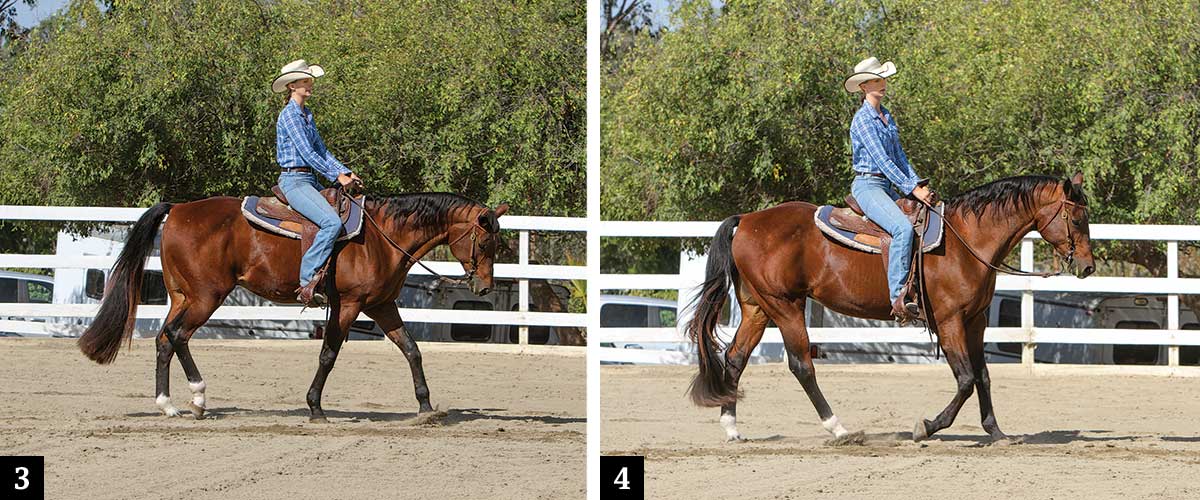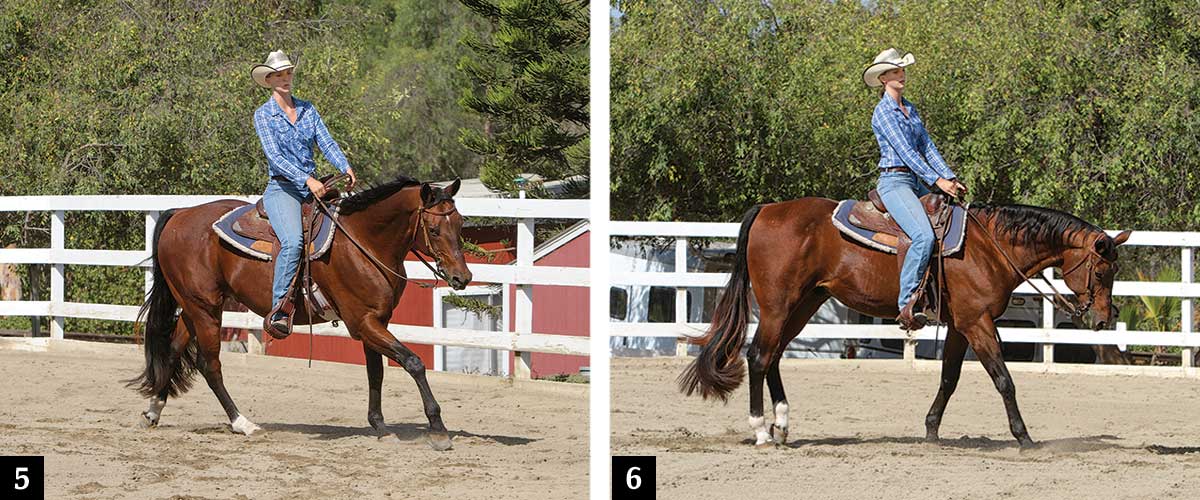Use a bit your horse responds to, and consider using spurs if your horse is lazy. Use two hands on the reins for the best control and clearest cues from your hands, then advance to one-handed riding once you and your horse are dialed in to the transition cues.
Warm up your horse so he’s ready to listen for random, ongoing cues for speed changes. Be ready to put in effort for this session—your repeated upward and downward transitions will require your body to work hard in the saddle.

One
Begin at a jog. Pay attention to your horse’s cadence so he’s balanced in his gait. Keep contact with the bit, and drive him forward with your seat to maintain a consistent stride and pace. Look forward, and keep your torso square. The more correct your riding position, the more effective you’ll be.
Two
Ask your horse to extend his jog. Extension means a longer stride, not faster feet. Tap with both heels for an even “go forward” cue, put your hands forward to encourage his extension, and cluck or kiss. Ideally, your upward transition should take two or three strides. If it takes longer, be more assertive with your cues. Also check that you’re not inhibiting his forward motion by keeping your reins too tight. If your horse breaks into a lope, you’re using too much cue and need to back off a little.

Three
Transition back down to a jog without walking. If you’ve been posting the extended trot, cease that motion. Sit deeply on your pockets—not back behind your horse’s motion—to shorten his stride back down to a jog. If your horse is familiar with a voice cue to rate back, use it; but keep your legs on him to maintain a two-beat gait. Once you achieve the transition, you can let up a little with the leg pressure to the same level you had in Photo 1. These cues require you to know your horse and the level of cueing he requires. It’ll take trial and error to master the correct mix of pressure.
Four
Pick up a nice and easy lope. Again, be sure it’s a true gait with three
beats and even cadence. Keep soft contact with your horse’s mouth, and drive him from behind for a collected, even lope. Just as with the jog, maintain proper position in the saddle so you can be an effective rider. Pay close attention to your horse’s footfalls so you notice when he reaches the desired level of extension when you ask for it in the next step.

Five
Extend your horse’s lope by using pressure from your legs and kissing or clucking to him. Keep control at this faster gait by maintaining soft contact with the bit, but not so much that you hold back your horse’s motion. Again, it should take two or three strides to achieve the gait extension, just as with the jog/extended trot transition. No matter the gait you’re working on, take more strides if necessary to get it correct. Transitioning incorrectly in two strides isn’t an achievement if the transition is sloppy or lacks control.
Six
Ease back down to a slower lope by slowing your motion in the saddle, sitting deeply in your seat, and softening your leg pressure. Maintain slightly more pressure with your outside leg to keep your horse in a lope and to ensure that he doesn’t drop all the way to a jog or walk. Use minimal hand cues here to keep from confusing him about what you want. Too much pressure from your hands could make him think you want to drop to a jog or walk, or even stop. Repeat these transitions multiple times in each riding session. They’ll help you determine exactly how much cue your horse needs for each change of gait.






